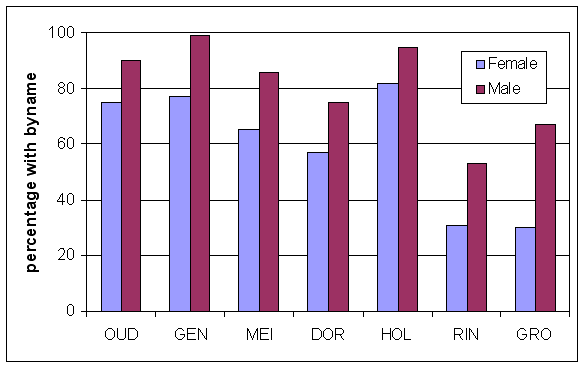In the 13th century most inhabitants of the Low Lands were registered with a byname:
59% of the women and 86% of the men.
In the calculation of these percentages, I did not count the persons that were mentioned exclusively in a byname
(for instance Robbrecht ser Alarts sone: Robbrecht was counted for the calculation of the percentage of men with a byname, but not Alart).
In earlier centuries, before 1000 AD, bynames were used less frequently, especially among the common people.
Nobles and clerics had bynames more often, but still less than in the 13th century.
(see Names in the Low Lands before 1150).
In the early Middle Ages bynames were not hereditary, like our modern family names
Also in the present survey, during the High Muddle Ages, bynames were not yet hereditary.
The increase in bynames was undoubtedly related with the decreased variation in given names, and possibly also with the rise of the towns.
In the early Middle Ages we saw a great diversity in given names, especially Germanic given names, and additions were not really necessary: each villager had a unique given name to identify him or her.
With the decreasing variation and the rise of larger towns, chances increased for two or more people in the same community to have the same given name. Thus, bynames were required to tell individuals apart.
The figure below shows that bynames occurred less frequently in the northern locations.
Those were the regions where Germanic given named remained most popular.
Furthermore, it can be seen that bynames were less common among women compared to men, as was the case in the early Middle Ages.

The relative frequencies of bynames in the seven locations, among women and men.
For the meaning of the bynames, I used Debrabandere's Dictionary of Family Names (2003), and the Middelnederlandsch Woordenboek (1998).
Most bynames could be classified in one of the categories as distinguished by
Scott and Mittleman (1999).
- locative
- A reference to a town (Egbertus de Groninge), a region (Janne den Vlaminc), or another location (Truden van den Damme, Iohannes van den Hove).
This was the most important category of bynames (41%).
- kinship
- Kinship names were mostly patronyms (Bernardo filio Godeweris), but also matronyms (Heine ver Lisebetten sone) and other family relationships (lisebette willem mesmakers wedewe, Gilise sheren Vrederics neve, Ghela uxor Oudrauen).
This was the second category of bynames (25%).
- occupational and status
- Noble ranks (beatrijs gravinne), clerical functions (Hermannus plebanus) and professions of common citizens.
The common professions appeared often in the 13th century sources, much more than in the early Middle Ages.
This was the third category (19%).
The occupations found are listed at the Occupational names and Nicknames Page.
- nickname
- Nicknames pointed at some specific trait of the bearer. They were sometimes neutral (Clais de Brune), often not very flattering (Henrico dictus Cum Macula, Woutre callart) and occasionally rather funny (Gobel Colsebyle - Hose bottom, Tielekine Arnouds sone die niene verloech - who never laughed).
Nicknames were the fourth category of bynames (15%).
All nicknames found are listed at the Occupational names and Nicknames Page.
- occupation-nickname
- The official term is: metonymic names.
Craftsmen were sometimes nicknamed after the product they made or a tool they used.
Here, these occupation-nicknames have been considered as a separate category.
Of all bynames, 2% were metonymic.
They are listed at the Occupational names and Nicknames Page.
- second given name
- A second given name, different from the first given name (Clara dicte Elyzabet). This type of byname was rare (1,4%).
- unknown
- In 4% of the bynames I was not sure in what category they belonged.
Sometimes the meaning of a word was unknown, or a word could have several meanings.
- multiple bynames
- If you add up the percentages given above, you come to more than 100%. That's because some persons (7%) had a double byname, such as Gillis die witte dhudeuettere (nickname and occupation), Gerardus de Vden filius Ludolfi de Vden (locative and patronyme), and Florens Graue van Hollant (occupation/rank and location).
In my study of early-medieval bynames, 'occupational and status' was the most frequent category, followed by locations and kinship (see Names in the Low Lands before 1150).
The occupational and status names scored so high, because clerics biased the overall picture:
clerics were registered relatively often in early-medieval charters, and often with their function (presbiter, prepositus) as an addition after their first name.
In the present survey there were much more common citizens. Among them, just as in the early Middle Ages, locative names formed the major category, followed by kinship, occupational names and nicknames.
Second given names were also unusual in the early Middle Ages, and double bynames did already occur.
Thus, as far as the distribution of the types of bynames is concerned, there were no great changes to be seen.
However, the overall frequencies of bynames clearly increased.
|

